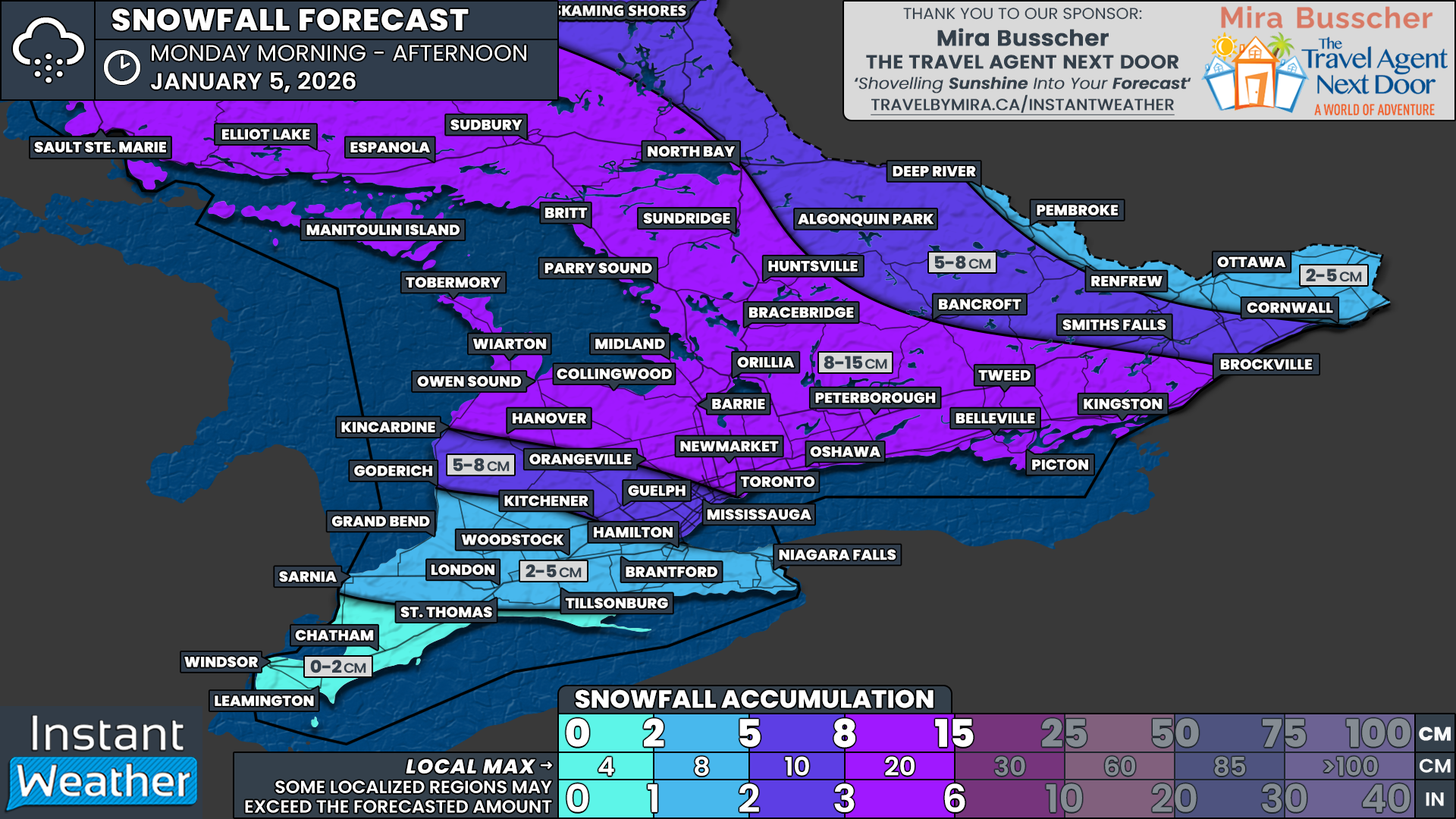Prolonged Freezing Rain Threatens Icy Start to Week for Parts of Southern Ontario on Monday
/December has kicked off with a cold and snowy start across Southern Ontario, as a significant lake-effect snow squall outbreak blanketed parts of the snowbelt over the past week. This wintry weather was accompanied by the season's first blast of Arctic air, bringing wind chills as low as -20°C.
However, a shift in the weather pattern is underway, with milder conditions already spreading into Southwestern Ontario, where Sunday saw daytime highs climbing into the mid to upper single digits.
A weather system is expected to arrive early Monday, bringing warmer air aloft, while near-surface temperatures hover around freezing. This setup creates ideal conditions for freezing rain across parts of Central and Eastern Ontario, which, according to the latest data, could last for an extended period.
Freezing rain is expected to begin in the morning hours on Monday, persisting through the afternoon and into the evening. This prolonged event could result in a thin but hazardous layer of ice forming on untreated surfaces such as roads, sidewalks, trees, and power lines, with localized power outages a possibility.
PRECIPITATION TYPE - MAP FROM WEATHERBELL
The initial bands of precipitation will move into Deep Southwestern Ontario, including Windsor and London, during the pre-dawn hours on Monday. Temperatures in this region will remain several degrees above freezing throughout the day, so precipitation here is expected to fall as rain.
As the system progresses north and east during the morning, it will encounter below-freezing temperatures near the surface in areas like the Dundalk Highlands (including Orangeville and Shelburne) and parts of the Greater Toronto Area (GTA).
This will result in the development of freezing rain, creating a zone stretching from Orangeville eastward through York Region, along the higher elevations of the Oak Ridges Moraine, and into southern portions of Central and Eastern Ontario.
This band of freezing rain is expected to persist into the early afternoon, with locations such as Barrie, Orillia, Kawartha Lakes, Peterborough, and Belleville likely experiencing the heaviest impacts.
Further north, areas like Muskoka, Bancroft, and the Ottawa Valley are expected to see a mix of wet snow, ice pellets, and freezing rain beginning early Monday afternoon. While significant snowfall accumulation is not expected for Southern Ontario, enough snow could fall to create slushy and slippery road conditions in these areas.
PRECIPITATION TYPE - MAP FROM WEATHERBELL
Freezing rain will begin to taper off in the south later in the afternoon, though freezing drizzle may linger into the early evening. Temperatures are forecast to rise slowly above freezing later in the evening and overnight, which should help melt any accumulated ice, albeit gradually.
In more northern portions of Central and Eastern Ontario, heavier freezing rain will persist into Monday evening before ending overnight. However, freezing drizzle may continue in the Ottawa Valley into early Tuesday morning, potentially causing icy conditions for the Tuesday morning commute.
The most significant freezing rain impacts are expected in a narrow corridor extending around Lake Simcoe and eastward along the Lake Ontario shoreline.
Ice accretion of 2 to 5mm is possible in areas such as Orangeville, Newmarket, Collingwood, Barrie, Orillia, Midland, Bracebridge, Lindsay, Peterborough, Oshawa, Belleville, and Kingston.
For the rest of Central and Eastern Ontario, including the Ottawa Valley, up to 2mm of ice accretion is expected, accompanied by ice pellets and a few centimeters of wet snow.
In the GTA, the greatest impacts from freezing rain will likely occur in the northern and eastern portions of the region. Toronto may experience brief freezing rain during the morning hours, but it is expected to transition quickly to rain, especially closer to the lakeshore.















































